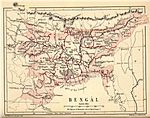
Chandra dynasty

This article includes a list of general references, but it lacks sufficient corresponding inline citations. (April 2015) |
| History of Bengal |
|---|
 |
The Chandra dynasty was a Buddhist dynasty, originating from the South East Bengal region of Indian subcontinent, which ruled the Samatata area of Bengal, as well as Arakan. Later it was a neighbor to the Pala Empire to the north. Rulers of Chandra kingdom were adherents of Buddhism. The Kings of Chandra dynasty were identified as the kings of Vangaladesha in the Tirumulai inscription of Chola dynasty.[1] The dynasty was founded around the 4th century AD.

History
The Anandachandra Inscription (729 AD) mentions that the Chandra dynasty was established by Dvenchandra (or Mahataing Chandra) in 370 AD. He had assumed the throne after the end of the Annaveta dynasty.[2] The ye Dhamma inscriptions of the Queen of Niti Chandra are dated to early 6th century AD based on paleographic grounds.[3]

The Chandra kingdom was one of the last Buddhist strongholds in the Indian subcontinent. The kingdom flourished as a center of the Tantric schools of Buddhism. It played a role in the diffusion of Mahayana Buddhism to Southeast Asia.[4]

King Srichandra led invasions into Kamarupa. The Chandras played an important role in the regional politics and military history of erstwhile Bengal.

In the reign of King Govindachandra, the Chandras were eventually overthrown during an invasion by the Chola dynasty of South India.[5]

| # | King | Period | Reign (CE) |
|---|---|---|---|
| Ruling from Dhanyawadi and Waithali | |||
| 1 | Dvenchandra[2][6][7] | 55 | 370-425 |
| 2 | Rajachandra | 20 | 425-445 |
| 3 | Kalachandra | 9 | 445-454 |
| 4 | Devachandra | 22 | 454-476 |
| 5 | Yajnachandra | 7 | 476-483 |
| 6 | Chandrabandu | 6 | 483-489 |
| 7 | Bhumichandra | 7 | 489-496 |
| 8 | Bhutichandra | 24 | 496-520 |
| 9 | Nitichandra | 55 | 520-575 |
| 7 | Virachandra | 3 | 575-578 |
| 11 | Pritichandra | 12 | 578-90 |
| 12 | Prithvichandra | 7 | 590-597 |
| 13 | Dhirtichandra | 3 | 597-600 |
| 14 | Mahavira* | 12 | 600-12 |
| 15 | Virayajap* | 12 | 612-24 |
| 16 | Sevinren* | 12 | 624-36 |
| 17 | Dharmasura* | 13 | 636-49 |
| 18 | Vajrashakti* | 16 | 649-65 |
| 19 | Dharmavijaya* | 36 | 665-701 |
| 20 | Narendravijaya* | 2 yr 9 months | 701-703 |
| 21 | Dharmachandra* | 16 | 703-720 |
| 22 | Anandachandra* | 9+ | 720-729+ |
| Ruling from Harikela[8] | |||
| 1 | Traillokyachandra | 30 | 900–930 |
| 2 | Srichandra | 45 | 930–975 |
| 3 | Kalyanachandra | 25 | 975–1000 |
| 4 | Ladahachandra | 20 | 1000–1020 |
| 5 | Govindachandra | 30 | 1020–1050 |
*Note- These rulers may or may not be related to the Chandra dynasty.[6][2]

Maritime relations
The coastal kingdom had trade networks with states in what is now Myanmar, Thailand, Indonesia and Vietnam. 10th century shipwrecks around the coast of Java provide evidence of maritime links between southeastern Bengal and Southeast Asia. Bronze sculptures may have been imported by the Javanese from the Chandra kingdom in southeastern Bengal. Arab merchants also traded with the kingdom.[4]

King Anandachandra mentions mission he sent to Sinhalese King Silamegha (Aggabodhi IV) (727-766)

Archaeology
There are numerous inscriptions dating from the period of the Chandra dynasty. The three archaeological sites associated with the dynasty include Bikrampur and Mainamati in Bangladesh and Waithali in Rakhine State, Myanmar (Burma).

Education
Chandrapur University in Shrihatta was as large as other religious institutions like Nalanda, Taxila, Mahasthangarh[9] or Odantapuri and was established before Oxford, and Cambridge universities or even the Jagaddala Vihara.[10][11][12] It was made by king Srichandra. Its exact location has not been found. Chandrapur university was unique in contrast with other universities and the viharas established by Buddhist kings in India. Its curriculum included almost all of the subjects from the Hindu Shastra except the grammar of Chandragomin who was Buddhist by religion. Moreover, the students of this university were also Hindu Brahmins. The nine monasteries were overseen mainly by Hindu Brahmins.[9] This is because the Buddhist king, Srichandra, granted lands in Paschimbhag in the name of Buddha for nine Brahmin monasteries where the Chaturvedas were mainly taught. Kamalakanta Gupta referred to this grant as "unique among other Buddhist kings" since it implies Srichandra's favouritism towards Brahmins.

Land distribution among 25 classes of people, guests, and students indicates an efficient administration in the universities. According to Zafir Setu, this administrative arrangement is more consistent with the present-day university system.[11]

References
- ^ Alam, Aksadul (2012). "Govindachandra". In Islam, Sirajul; Jamal, Ahmed A. (eds.). Banglapedia: National Encyclopedia of Bangladesh (Second ed.). Asiatic Society of Bangladesh.
- ^ a b c Singer, Noel F. (2008). Vaishali and the Indianization of Arakan. APH Publishing. p. 50. ISBN 978-81-313-0405-1.
- ^ Manguin, Pierre-Yves; Mani, A.; Wade, Geoff (2011). Early Interactions Between South and Southeast Asia: Reflections on Cross-cultural Exchange. Institute of Southeast Asian Studies. pp. 387–. ISBN 978-981-4345-10-1.
- ^ a b Ghosh, Suchandra (2013). "Locating South Eastern Bengal in the Buddhist Network of Bay of Bengal (C. 7th Century CE-13th Century CE)". Proceedings of the Indian History Congress. 74: 148–153. JSTOR 44158810.
- ^ Sirajul Islam; Miah, Sajahan; Khanam, Mahfuza; Ahmed, Sabbir, eds. (2012). "Chandra Dynasty, The". Banglapedia: the National Encyclopedia of Bangladesh (Online ed.). Dhaka, Bangladesh: Banglapedia Trust, Asiatic Society of Bangladesh. ISBN 984-32-0576-6. OCLC 52727562. OL 30677644M. Retrieved 17 November 2024.
- ^ a b Wicks, Robert S. (31 May 2018). Money, Markets, and Trade in Early Southeast Asia: The Development of Indigenous Monetary Systems to AD 1400. Cornell University Press. p. 87. ISBN 978-1-5017-1947-9.
- ^ Johnston, E. H. (1944). "Some Sanskrit Inscriptions of Arakan". Bulletin of the School of Oriental and African Studies, University of London. 11 (2): 357–385. doi:10.1017/S0041977X00072529. ISSN 0041-977X. JSTOR 609320. S2CID 191758063.
- ^ Chowdhury, Abdul Momin (1967). Dynastic History of Bengal (c. 750—1200 A.D.). Dacca: The Asiatic Society of Pakistan. pp. 156, 159, 170.
- ^ a b Islam, Mohammad Mazharul (17 August 2020). "প্রাচীন 'চন্দ্রপুর বিশ্ববিদ্যালয়'" (in Bengali). Samakal. Retrieved 31 August 2020.
- ^ Shakil, Mahfouz (20 July 2020). "জুড়ীতে প্রাচীন বিশ্ববিদ্যালয়? অনুসন্ধানে যাচ্ছে প্রত্নতত্ত্বের দল" (in Bengali). Kulaura, Moulvibazar: Kaler Kantha. Retrieved 12 April 2021.
- ^ a b Choedhury, Dwoha (24 July 2020). "চন্দ্রপুর: যেখানে লুকিয়ে আছে দশম শতাব্দীর বিদ্যাপীঠ". The Daily Star (in Bengali). Sylhet. Retrieved 27 August 2020.
- ^ Islam, Nurul (18 August 2020). "শুস্ক মৌসুমে খননকাজ: মৌলভীবাজারে প্রাচীন চন্দ্রপুর বিশ্ববিদ্যালয়ের সন্ধানে" (in Bengali). Moulvibazar: samakal. Retrieved 12 April 2021.
Bibliography
- Singh, Nagendra Kr. (2003). Encyclopaedia of Bangladesh. Anmol Publications Pvt Ltd. pp. 7–21. ISBN 81-261-1390-1.
- Chowdhury, A. M. (2012). "Chandra Dynasty, The". In Islam, Sirajul; Jamal, Ahmed A. (eds.). Banglapedia: National Encyclopedia of Bangladesh (Second ed.). Asiatic Society of Bangladesh.
See what we do next...
OR
By submitting your email or phone number, you're giving mschf permission to send you email and/or recurring marketing texts. Data rates may apply. Text stop to cancel, help for help.
Success: You're subscribed now !
